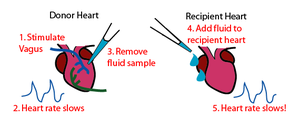User talk:Nrets/sandbox1
Vagusstoff refers to the substance released by stimulation of the vagus nerve which causes a reduction in the heart rate. Discovered in 1921 by pharmacologist Otto Loewi, vagusstoff was the first confirmation of chemical synaptic transmission and the first neurotransmitter ever dicovered. It was later confirmed to be acetylcholine, which was first identified by Sir Henry Hallett Dale in 1914. Because of his pioneering experiments, in 1936 Loewi was awarded the Nobel Prize in Physiology or Medicine, which he shared with Dale.
The discovery of Vagusstoff[edit]

By the time Loewi began his experiments there was much discussion among scientists whether communication between nerves and muscles was chemical or electrical by nature. Experiments by Luigi Galvani in the 18th century had demonstrated that electrical stimulation of the frog sciatic nerve resulted in twitching of the leg muscles, and from this he developed the concept of bioelectricity. This led to the idea that direct electrical contact between nerves and muscles mediated transmission of excitation. However, work by John Newport Langley had suggested that in the autonomic nervous system communication in the ciliary ganglion was chemical. Loewi's experiments, published in 1921 [1] finally settle the issue, proving that synaptic transmission was chemical.

Loewi performed a very simple yet elegant experiment. Using an isolated frog heart he had previously found that stimulation of the vagus nerve resulted in a slowing of the [heart rate]], while stimulation of the sympathetic nerve caused the heart rate to speed up (Figure 1). He reasoned that stimulation of either the vagus or sympathetic nerve would cause the nerve terminal to release a substance which would either slow or accelerate the heart rate. To prove this, he took a frog heart, which had been cannulated in order to perfuse the fluid surrounding the heart, and electrically stimulated the vagus nerve until the heart rate slowed. He then collected the fluid surrounding the heart and added it to a second frog heart which had been stripped of its vagal and sympathetic nerves. By adding the fluid surrounding the first heart to the second heart, he caused the heart rate of the second heart to slow down. This proved that stimulation of the vagus nerve caused the release of a substance which diffused into the heart tissue and could directly cause the heart rate to slow down. (Figure 2) This substance was called vagusstoff. Vagustoff was later confirmed to be acetylcholine and was found to be the principal neurotransmitter in the parasympathetic nervous system.

In an interesting aside, Loewi apparently had the idea for his experiment in a dream. He wrote it down in the middle of the night but the next morning could not decipher his writing. He eventually had the same dream on another night, and decided to run to the laboratory to perform the experiment in the middle of the night. About this incident, Loewi writes: On mature consideration, in the cold light of the morning, I would not have done it. After all, it was an unnlikely enough assumption that the vagus should secrete an inhibitory substance; it was still more unlikely that a chemical substance that was supposed to be effective at very close range between nerve terminal and muscle be secreted in such large amounts that it would spill over and, after being diluted by the prfusion fluid, still be able to inhibit another heart. (Loewi 1921)
Sources[edit]
- O. Loewi (1921) "Uber humorale Ubertragbarkeit der Herznervenwirkung. I." Pflugers Archiv, 189, pp. 239-242 [2]
- M.R. Bennett (2000) "The concept of transmitter receptors: 100 years on", Neuropharmacology, 39(4):523-46.
- J.G. Nicholls, A.R. Martin, B.G. Wallace and P.A. Fuchs. "From Neuron to Brain". 4th ed. Sinauer Associates, Sunderland, MA. ISBN 0878924391
